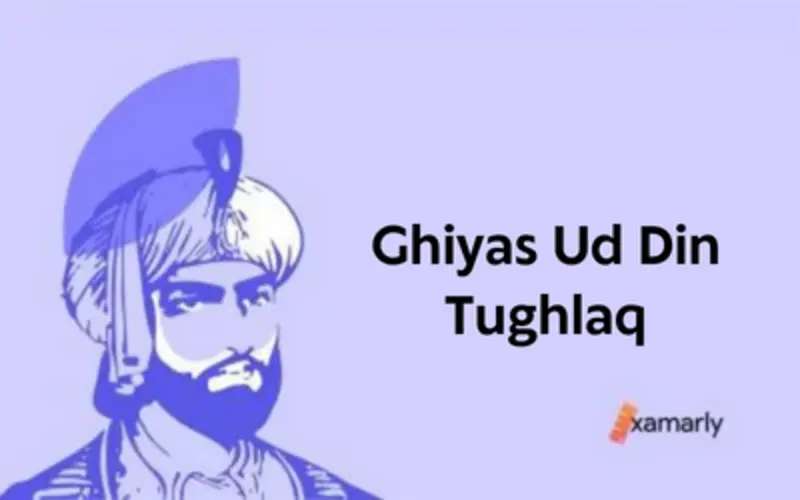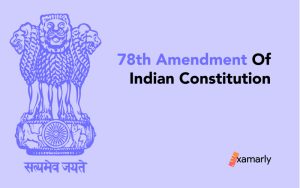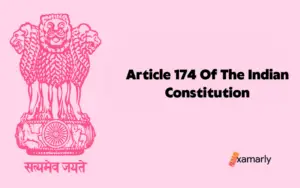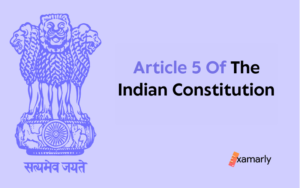The Tughlaq dynasty in India was started by Ghiyas ud din Tughlaq (Ghazni malik) who ruled the Delhi Sultanate from 1320 to 1325 just after assassinating Khusrau Khan. Khusrau Khan was the last ruler of the Khilji dynasty.
For assassinating Khurso Khan, the sultan’s title was rewarded to him. He was intelligent, and he used his all tactics, plans, and qualities to build the empire. Peace and harmony were maintained during his reign.
He was born to a Turkish father and a Jat mother. Under Ala-ud-Din Khilji’s service, he was the Governor in charge of the frontier areas.
To read about Alauddin Khilji for UPSC preparation or any other competitive examination, click on the linked article.
His successor was Muhammad Bin Tughlaq. The 14th-century historians claim that his death was the result of a conspiracy against him. He was a very wise and great ruler.
Ghiyas ud din also known as Ghazi Malik, will be covered in this article as a resource for UPSC exam preparation.
- Reign Of Ghiyas ud din Tughlaq
- Domestic And Foreign Policies
- Administration
- Conquest
- End Of Rule
- Successor
- Tomb
- Conclusion
- Frequently Asked Questions
- Who was Ghiyas Ud Din Tughlaq?
- When was Ghiyas Ud Din Tughlaq born?
- What was Ghiyas Ud Din Tughlaq known for?
- When did Ghiyas Ud Din Tughlaq become the Sultan of Delhi?
- How did Ghiyas Ud Din Tughlaq die?
- Who succeeded Ghiyas Ud Din Tughlaq as the Sultan of Delhi?
- Where was Ghiyas Ud Din Tughlaq buried?
- What was the Tughlaq dynasty?
- What were the major accomplishments of Ghiyas Ud Din Tughlaq?
- What was the relationship between Ghiyas Ud Din Tughlaq and his son, Mohammad-bin-Tughlaq?
Reign Of Ghiyas ud din Tughlaq
- Ghiyas ud din Tughlaq established the Tughluq dynasty. He ruled the Delhi Sultanate between 1320 and 1325. Mongols were the target of Tughluq’s stern policy.
- He had assassinated Oljeitu’s agents. Under him, the Mongol captives were treated ruthlessly.
- He finally emerged victorious in the Battle of Amroha in 1305.
- During his travel from Multan to Delhi, the Soomro clan rose and gained control of Thatta.
- Tajuddin Malik was appointed as the governor of Multan.
- Khwajah Khatr as the governor of Bhakkar, and Malik Ali Sher as the governor of Sehwan by Tughluq.
- He dispatched his son Fakhruddin Jauna on an expedition to the Kakatiya capital Warangal in 1323. He would later come to be known as Muhammad bin Tughluq.
- The Siege of Warangal followed. On this victorious occasion, Warangal was annexed thereby overthrowing the Kakatiya kingdom was overthrown.
- Muhammad Shah, his son, was proclaimed as the natural heir in 1323. Following that, he had the ministers and nobility of the realm make a formal commitment of consent to the arrangement.
- Ghiyas ud din also started building the Tughlaqabad Fort.
- He built a stable government controlled by Multanis throughout his reign. This reflected both his local power base of Punjab and Dipalpur and the strategies he used to seize power.
- Taking advantage of the progressing war of Bengal, he conquered Bengal also.
Domestic And Foreign Policies
- In his dominion, Ghiyas ud din reinstituted order.
- He prioritized enforcement of the law and judicial governance. Under his reign, agricultural, irrigational and legal systems developed.
- He took over Warangal, Bengal, and Utkala or Orissa.
- The Mongol leaders that invaded North India were captured and put in prison by him.
Administration
- His administration was concreted by the ideals of moderation and justice.
- The Sultan organized the land revenue and took extensive efforts to prevent fraud.
- The treatment of cultivators was excellent, and authorities who misbehaved faced harsh punishment.
- The efficient work of the justice and police units could be felt even in the most outlying parts of the kingdom. These departments ensured maximum security.
- He implemented a tax system to strengthen the finances of the state.
- The monarch, according to Barani, thought that taxes should be levied to prevent people from becoming blinded by money and afterwards becoming discontented and rebellious; on the other side, from being brought to misery and destitution that they are incapable to chase their daily bread.
- He improved the canal, bridge, and road conditions. He also enhanced the communication methods and services.
- He strengthens the postal system
- He improved the agriculture system.
- Food laws of Ala-ud-din were again imposed by him.
Conquest
- Pratap Rudra Deva II, the monarch of Warrangal, declared his independence after Ala-ud-Din passed away. As a result, two expeditions were launched against him in 1321 and 1323. He lost a duel, and the Delhi Sultanate now includes his kingdom.
- In Bengal, the two Bughra Khan grandchildren were fighting openly. By attacking Bengal and conquering a remarkable portion of that realm, the Sultan took advantage of this gap.
- The Sultan chanced upon the Raja of Tirhut while returning from Bengal. He overpowered the Raja of Tirhut. Thus, he conquered the Tirhut territories.
- These conquests allowed the Sultanate to extend its territorial influence, and Mohammad-bin-Tughlaq continued to pursue further expansion throughout his reign.
- However, his rule was marked by several controversial decisions, such as the shifting of the capital from Delhi to Daulatabad and the introduction of a failed currency reform.
- These decisions contributed to instability and unrest in the Sultanate.
End Of Rule
- In 1324, Ghiyas ud din Tughlaq’s focus shifted towards Bengal. A civil war had broken out in Bengal and needed his intervention. Post his victorious involvement, Nasiruddon was declared the ruler of West Bengal.
- On his return to Delhi, he battled Tirhut (north Bihar). The wooden pavilion that had been used for his welcome at Afghanpur collapsed in 1325. This catastrophe ended up killing both him and his second son, Prince Mahmud Khan.
- Ibn Batuta strongly asserted that the conspiracy was orchestrated. The mastermind was his vizier, Jauna Khan (Khwajah Jahan).
Successor
Ghiyas ud din was the Sultan of Delhi in the 14th century. He passed away in 1325, and after his death, his son Juna Khan, also known as Ulugh Khan, ascended the throne and became the new king.
Juna Khan was a military commander and had previously served as the governor of several provinces under his father’s reign.
Upon becoming the new king, Juna Khan changed his name to Mohammad-bin-Tughlaq. He was a learned and intelligent ruler, who had a keen interest in the arts, literature, and science.
However, his reign was marred by a series of controversial decisions and failed policies, such as the shifting of the capital from Delhi to Daulatabad and the introduction of a token currency.
Despite his shortcomings, Mohammad-bin-Tughlaq is still regarded as an important figure in Indian history, who made significant contributions to the development of arts and culture in his kingdom.
Tomb
Tughlaqabad was constructed by him sometime between 1321 and 1325. This became the third city in Delhi.
Almost 4 years were taken in creating this city. It was never populated and just fifteen years later, it was abandoned.
While the establishment of this city sultan ordered every worker to engage in its construction, at the same time the construction of the baoli was also going on by Nizamuddin Auliya.
So workers were working at Tughlaqabad in the daytime and at baoli in the nighttime. His mausoleum was surrounded by a pond. A causeway connected it to the Tughlaqabad fort.
The tomb is positioned in the centre of a pentagonal area that is walled on all sides. The tomb is made of white marble and red sandstone. It is topped with an octagonal drum-shaped white marble canopy.
The sloping walls of the mausoleum inspired the design of all subsequent Tughlaq constructions. The tomb also houses the remains of his wife and son Muhammed Bin Tughlaq.
Conclusion
Ghiyas ud din expired in 1325 due to the failure of a pavilion that his son had hastily erected in Afghanpur, close to Delhi, to greet him before his formal entry into the city after his stunning victory in Bengal, failing to do so.
Whether his son had plans to overthrow him remains a mystery. There are many accounts each proclaiming various accounts of an accident or a conspiracy by his son to grab power. None of these can be factually proven.
After Ghiyas ud din Tughlaq passed away, his son, Muhammad Bin Tughluq took up the throne and proclaimed himself Sultan.
We’ve curated important information about Ghiyas ud din Tughlaq for UPSC exam preparation. Hope this blog has helped you prepare for your history exam more clearly!
Frequently Asked Questions
Who was Ghiyas Ud Din Tughlaq?
Ghiyas Ud Din Tughlaq was the Sultan of Delhi in the 14th century.
When was Ghiyas Ud Din Tughlaq born?
The exact date of Ghiyas Ud Din Tughlaq’s birth is not known, but he was born in the early 14th century.
What was Ghiyas Ud Din Tughlaq known for?
Ghiyas Ud Din Tughlaq was known for his military campaigns and for expanding the Delhi Sultanate’s territory.
When did Ghiyas Ud Din Tughlaq become the Sultan of Delhi?
Ghiyas Ud Din Tughlaq became the Sultan of Delhi in 1320 after deposing the previous ruler, Nasir Ud Din Khusro Shah.
How did Ghiyas Ud Din Tughlaq die?
Ghiyas Ud Din Tughlaq died in 1325, possibly due to illness.
Who succeeded Ghiyas Ud Din Tughlaq as the Sultan of Delhi?
Ghiyas Ud Din Tughlaq was succeeded by his son, Juna Khan (later known as Mohammad-bin-Tughlaq), as the Sultan of Delhi.
Where was Ghiyas Ud Din Tughlaq buried?
Ghiyas Ud Din Tughlaq was buried in the mausoleum complex known as Tughlaqabad, which he had built during his reign.
What was the Tughlaq dynasty?
The Tughlaq dynasty was a Muslim dynasty that ruled over the Delhi Sultanate from 1320 to 1414.
What were the major accomplishments of Ghiyas Ud Din Tughlaq?
Ghiyas Ud Din Tughlaq is known for expanding the Delhi Sultanate’s territory, building several forts and palaces, and establishing a separate department for public works.
What was the relationship between Ghiyas Ud Din Tughlaq and his son, Mohammad-bin-Tughlaq?
Ghiyas Ud Din Tughlaq had a close relationship with his son, Mohammad-bin-Tughlaq, and appointed him as the governor of several provinces before making him his successor.






